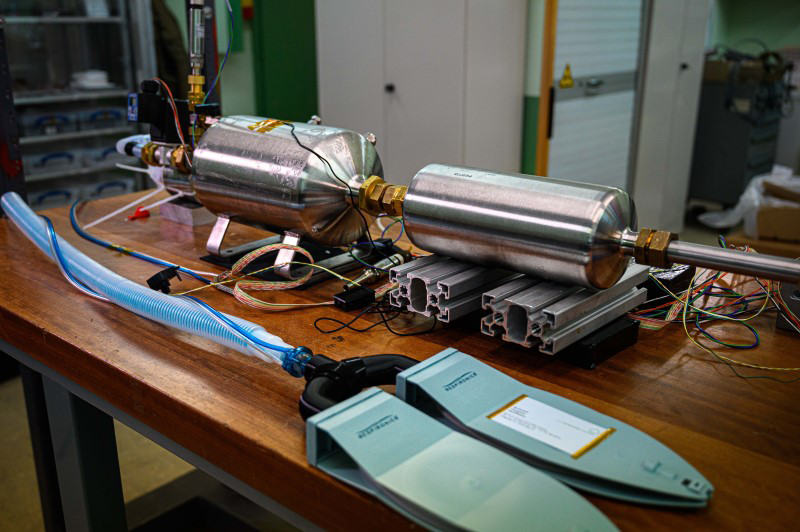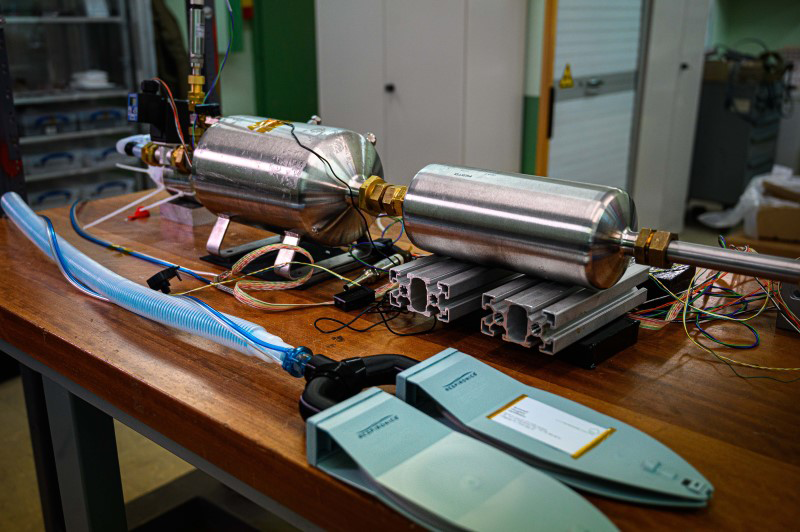Physicists Design Emergency Ventilators
In the COVID-19 crisis, many hospitals are suffering from a shortage of ventilators—medical devices that help patients breathe when their lungs fail to supply enough oxygen to their blood. To help meet the demand, three separate groups of physicists are employing their laboratory skills to make new designs of the machines. Their aim is to provide stripped-down ventilators that could be built quickly and cheaply but would be robust and reliable.
Ventilators regulate the air entering and exiting a patient’s lungs by controlling the pressure, flow volume, and oxygen concentration in a tube inserted into the patient’s trachea. Only a small percentage of patients with COVID-19 require ventilators, and the overall need is still uncertain. But there is a fear that hard-hit regions may need thousands of new ventilators.
Aware of this potential need, the DarkSide Collaboration began working on a no-frills machine called Mechanical Ventilator Milano (MVM) in early March. The project fits surprisingly well with the team’s dark matter research, since their liquid argon detector in the Gran Sasso National Laboratory in Italy requires precise gas control systems. “Many people in the collaboration are leading experts in gas handling,” says DarkSide member Walter Bonivento from Italy’s National Institute for Nuclear Physics.
A similar reasoning motivated a group of researchers from CERN in Geneva. “We have particle detectors that are cooled with carbon dioxide,” says Paula Collins who works at the LHCb experiment at CERN. She and her colleagues decided to leverage their expertise with highly regulated gas systems to design a relatively simple ventilator. “There was this really good match between what we do and what a ventilator requires,” Collins says. Their efforts have led to the High Energy physics community Ventilator (HEV), whose design was posted on arXiv at the beginning of April. A third physicist-led group based in Portugal has also come up with a minimalist ventilator design using industrial components that should be easy to obtain even during COVID-19-related trade disruptions, says Paolo Fonte from the Laboratory of Instrumentation and Experimental Particle Physics in Portugal.
Of course, these physicists are far from the only ones working on emergency ventilators. On an industrial scale, several car manufacturers have teamed up with ventilator companies to produce tens of thousands of ventilators in the coming months. “If that covers the need, then that’s fantastic,” Collins says. But for now, it’s not certain that those industrial devices will arrive in time or that they will meet the need in certain places of the world. “We are not saying we have a magic solution that decades of ventilator manufacturing didn’t come up with,” Collins says. “We’re just trying to address the current crisis.”
The solution that all three physics teams are pursuing is a targeted ventilator. “Typical ventilators are multipurpose machines,” Bonivento says. They are designed to handle a wide range of patients with breathing problems, whereas COVID-19 patients have fairly specific symptoms. “If we are going to fight this one sickness, let’s go simple,” Bonivento says. By listening to medical professionals, he and his team have learned that precise pressure control is the most important element in treating COVID-19 patients. Rather than use complicated motors and turbines like current ventilators, the DarkSide’s MVM design takes pressurized oxygen as input and uses valves to regulate down to a target pressure in the range of 20 to 80 mbars.
CERN’s HEV design, by contrast, controls the pressure using a 10-liter tank as a buffer, where the pressure of the input gas can be reduced and checked before releasing it to the patient. The buffer provides both safety and reliability, Collins explains. Designing robust equipment comes naturally to her group. “Our experiments run for ten years in a high-radiation environment, so we can’t go in later and change something if it breaks,” she says. The goal is also to use commercially available components—like computer boards for hobbyists—that can be assembled quickly without special techniques.
All three groups have relied heavily on input from medical experts. Patrick Schoettker, an anesthesiologist from the Lausanne University Hospital, Switzerland, has consulted with the HEV team. He has outlined the ideal features of a ventilator for the physicists. “They have no expertise on physiology and gas exchange in the body, and I have no idea about the physics of fluids through pipes. We bring together ideas, and then we try to come to a solution,” Schoettker says. He cautions, however, that building a ventilator is not a do-it-yourself project, as any mistake in the pressure or flow volume can damage the lungs.
Testing is underway for all three ventilator designs. Farthest along is MVM, which has tested a prototype with a silicon lung that simulates human breathing. Bonivento says they have now built five production units that could be shipped to hospitals, but they are waiting for authorization from government agencies. They have had contact with the Civil Protection Department in Italy, and Bonivento expects a decision in a few weeks. Members of the MVM team in North America—led by Nobel Laureate Art McDonald of Queen’s University in Canada—are currently working on certification with Canadian and US health agencies.
The HEV team has completed a demonstrator device and three prototypes for testing. One prototype is now being extensively tested with a simulator, called TestChest. This device evaluates the performance of a ventilator by simulating the breathing of different pathologies, including the acute respiratory distress syndrome that occurs in severe COVID-19 cases. TestChest was originally meant for training personnel on how to use a ventilator, explains CEO Josef Brunner of Neosim, the Swiss company that makes the device. But now he is receiving requests from developers wanting to test their ventilators. In addition to physicist groups, several makeshift teams of engineers and medical professionals have formed around the world. Brunner has followed the ventilator industry for decades and believes these small groups could hit on creative solutions that bigger industries have missed.
Still, all the required tests and certifications will take time. Schoettker, the anesthesiologist helping the CERN team, thinks it may take months before emergency ventilators could be authorized for patient use. That might be too late for certain countries, but the pandemic will last months and will strike other regions where such streamlined ventilators could become an important line of defense, Schoettker says. The physicists working on these ventilators are not concerned over whether their designs get used or not; they simply want to help in any way they can. “I have been working for three weeks nonstop on our ventilator,” says Fonte of the Portuguese team. “But my hope is that it won’t be needed.”
–Michael Schirber
Michael Schirber is a Corresponding Editor for Physics based in Lyon, France.





